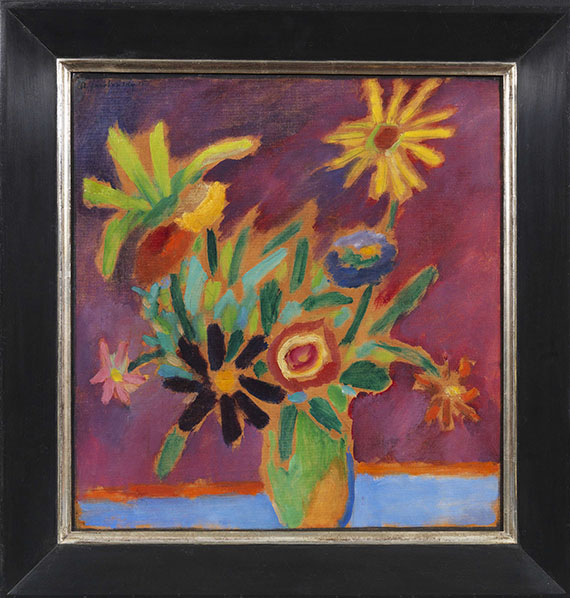103
Alexej von Jawlensky
Bunte Blumen, 1915.
Oil on structured wove paper, laid on canvas
Estimate:
€ 140,000 / $ 165,200 Sold:
€ 262,500 / $ 309,750 (incl. surcharge)
Bunte Blumen. 1915.
Oil on structured wove paper, laid on canvas.
Jawlensky/Pieroni-Jawlensky 729. Signed and dated in upper left. 52.6 x 49.4 cm (20.7 x 19.4 in).
• Very notable provenances.
• Early still life from the days of Jawlensky's exile in Switzerland.
• Rare document of Jawlwensky's free and unconventional spirit.
• Of irresistible intensity.
PROVENANCE: Kunstsalon Wolfsberg, Zürich (since 1916, with label on the stretcher).
Paul Kantor Gallery, Beverly Hills (since 1957, with gallery label on the stretcher).
Collection Dr. Pedro Vallenilla, Caracas.
Private collection Paris (1962-1967).
The New Gallery, New York (with gallery label on the stretcher).
Collection Herbert Kende, Los Angeles (since 1967).
Galerie Thomas, Munich.
Private collection Cologne.
EXHIBITION: Cuno Amiet, H. Berger, E. Egger, Alexej Jawlensky, Arthur Segal, Kunstsalon Wolfsberg, Zürich, July to August 1916, presumably cat. no. 69, titled "Blumen, Fantasie" (no illu.).
LITERATURE: Sotheby's, London, July 5, 1962, lot no. 312 (with illu. on p. 167).
Sotheby's, London, April 26, 1967, lot no. 67 (with illu. on p. 122).
Oil on structured wove paper, laid on canvas.
Jawlensky/Pieroni-Jawlensky 729. Signed and dated in upper left. 52.6 x 49.4 cm (20.7 x 19.4 in).
• Very notable provenances.
• Early still life from the days of Jawlensky's exile in Switzerland.
• Rare document of Jawlwensky's free and unconventional spirit.
• Of irresistible intensity.
PROVENANCE: Kunstsalon Wolfsberg, Zürich (since 1916, with label on the stretcher).
Paul Kantor Gallery, Beverly Hills (since 1957, with gallery label on the stretcher).
Collection Dr. Pedro Vallenilla, Caracas.
Private collection Paris (1962-1967).
The New Gallery, New York (with gallery label on the stretcher).
Collection Herbert Kende, Los Angeles (since 1967).
Galerie Thomas, Munich.
Private collection Cologne.
EXHIBITION: Cuno Amiet, H. Berger, E. Egger, Alexej Jawlensky, Arthur Segal, Kunstsalon Wolfsberg, Zürich, July to August 1916, presumably cat. no. 69, titled "Blumen, Fantasie" (no illu.).
LITERATURE: Sotheby's, London, July 5, 1962, lot no. 312 (with illu. on p. 167).
Sotheby's, London, April 26, 1967, lot no. 67 (with illu. on p. 122).
Upon the outbreak of World War I all Russian citizens were forced to leave Germany within just two days, among them also Alexej von Jawlensky. Unlike Wassily Kandinsky, who had decided to return to Moscow, Jawlensky emigrated to Switzerland where he found refuge with friends in St. Prex on Lake Geneva. With the decision to emigrate Jawlensky did not only leave a lot of personal belongings behind in Munich, it seems that he also abandoned themes and painting style that he had previously acquired. What he took with him to his new residence, however, was a style characterized by a boosted bright expressiveness rendered in playfully orchestrated motifs, a stylistic path that commenced with his stay in Bordighera in spring of 1914. This stay also saw the birth of his meaningful Variations, the first work series that would decisively coin his pictorial program. In this sense the ”Bunte Blumen“ (Colorful Flowers) are a kind of recreative intermission, a deep breath in the vast amount of his ”variations of a landscape theme“, in which Jawlensky rendered the view of the garden from his window several times a day over an extended period of time. Capturing the trees and the sky above the path leading down to the lake in a characteristic interplay of forms and colors, ”with the power of my mind and the inspiration found by the spirit of the ambient nature“, as Jawlensky wrote in his memoirs. Jawlensky painted these summery flowers in full bloom, reaching out to the light in seemingly wild gestures and in a likewise gaudy vase on a light-blue ground in front of a deep violet wall. The omnipresent strong orange tone invigorates the composition and determines the tenor of the quintessentially gaudy motif. It is not just the boisterously arranged bouquet of impetuously painted summer flowers - yellow coneflower, red zinnia, red-black Mexican aster, yellow lily, red poppy and others – that strike the observer, but also the artist’s pure zest for painting that finds expression in an insouciant performance. Jawlensky’s free spirit, his strong independence and rejection of conventions become tangible throuh these irresistibly intensive colors. [MvL]
103
Alexej von Jawlensky
Bunte Blumen, 1915.
Oil on structured wove paper, laid on canvas
Estimate:
€ 140,000 / $ 165,200 Sold:
€ 262,500 / $ 309,750 (incl. surcharge)
Headquarters
Joseph-Wild-Str. 18
81829 Munich
Phone: +49 89 55 244-0
Fax: +49 89 55 244-177
info@kettererkunst.de
Louisa von Saucken / Undine Schleifer
Holstenwall 5
20355 Hamburg
Phone: +49 40 37 49 61-0
Fax: +49 40 37 49 61-66
infohamburg@kettererkunst.de
Dr. Simone Wiechers / Nane Schlage
Fasanenstr. 70
10719 Berlin
Phone: +49 30 88 67 53-63
Fax: +49 30 88 67 56-43
infoberlin@kettererkunst.de
Cordula Lichtenberg
Gertrudenstraße 24-28
50667 Cologne
Phone: +49 221 510 908-15
infokoeln@kettererkunst.de
Hessen
Rhineland-Palatinate
Miriam Heß
Phone: +49 62 21 58 80-038
Fax: +49 62 21 58 80-595
infoheidelberg@kettererkunst.de
We will inform you in time.




 Lot 103
Lot 103 

